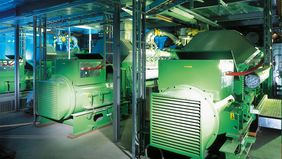
STEAG scores with CHP bids
Essen/Saarbrücken. In the current tendering process instituted by the German Federal Network Agency for project funding in the field of combined heat and power generation (CHP), STEAG has achieved a highly successful result. Governmental funds were awarded to projects with a plant capacity of 68.5 megawatts (MW). Half of those funds, for 34 MW, go to STEAG projects at sites in Saarland and Thuringia. CHP plants generate electricity and heat simultaneously, and are therefore especially apt for conserving resources and protecting the climate.
The Saarbrücken-based STEAG subsidiary STEAG New Energies GmbH participated in the tendering process with four projects – and all four projects were awarded funding. “We are delighted with this result. After all, in addition to our success in the projects concerned, the decision by the Federal Network Agency also demonstrates the high level of technical and energy management expertise that distinguishes STEAG,” says Dr. Markus Laukamp, Managing Director of STEAG New Energies. Without this know-how, he says, participation in processes like these has no prospect of success. STEAG was already successful with projects in the two previous CHP tenders in 2019.
Investments in climate-friendly heat supply
All four projects will ensure that local heat supply in the future will once again significantly reduce CO2 emissions and thus become even more climate-friendly. For example, two additional combined heat and power (CHP) units with a total capacity of 4 MW are being built at the Weiher power plant site in Quierschied, Saarland. The heat produced there is to be fed into the local heating network, which is operated by Fernwärme-Verbund Saar GmbH.
The situation is similar at the sites in Homburg in Saarland and Sömmerda in Thuringia. There, STEAG New Energies operates heating networks together with municipal partners: the Stadtwerke Homburg and the Sömmerdaer Energieversorgung municipal utilities. New plants are now being built at both locations, each with a capacity of 6 MW for the local heating networks.
Modernization in Völklingen-Fenne
The fourth project for which funding was awarded is a modernization of heat generation at the STEAG power plant site in the Fenne district of Völklingen, Saarland. There, STEAG operates an engine-based cogeneration plant previously fueled with mine gas with a total capacity of 42 MW, consisting of 14 individual gas engines. The heat generated is fed into the Saar district heating network.
“Here, however, the mine gas volume has been declining in the course of the years. It is currently no longer sufficient to adequately supply all 14 engines,” project manager Benjamin Fuchs reports. “That is why we have decided to modernize six of these gas engines and convert them to natural gas firing. This measure also contributes to securing the district heating supply in the long term – true to the STEAG motto: “Securing energy supply. Now and in the future.”
STEAG significantly reduces CO2 emissions
Together, all four projects provide for a structural reduction of CO2 emissions amounting to 20,000 metric tons each year. By way of comparison, this amount corresponds to the annual CO2 emissions of around 6,100 mid-range cars with an annual mileage of 25,000 kilometers.
STEAG has been working successfully for years to improve its carbon footprint. The company reduced its own CO2 emissions in Germany by 79 percent between 1990 and the end of 2019. This means that STEAG has already significantly exceeded the reduction targets to which Germany has committed itself under international agreements: The Federal Republic plans to reduce its own greenhouse gas emissions by 35 percent from 1990 to 2020 and by 55 percent by 2030.
“We have long since achieved these figures, and thanks to projects such as the CHP plants now being built, we are constantly improving STEAG’s ecological balance sheet,” says Markus Laukamp.
